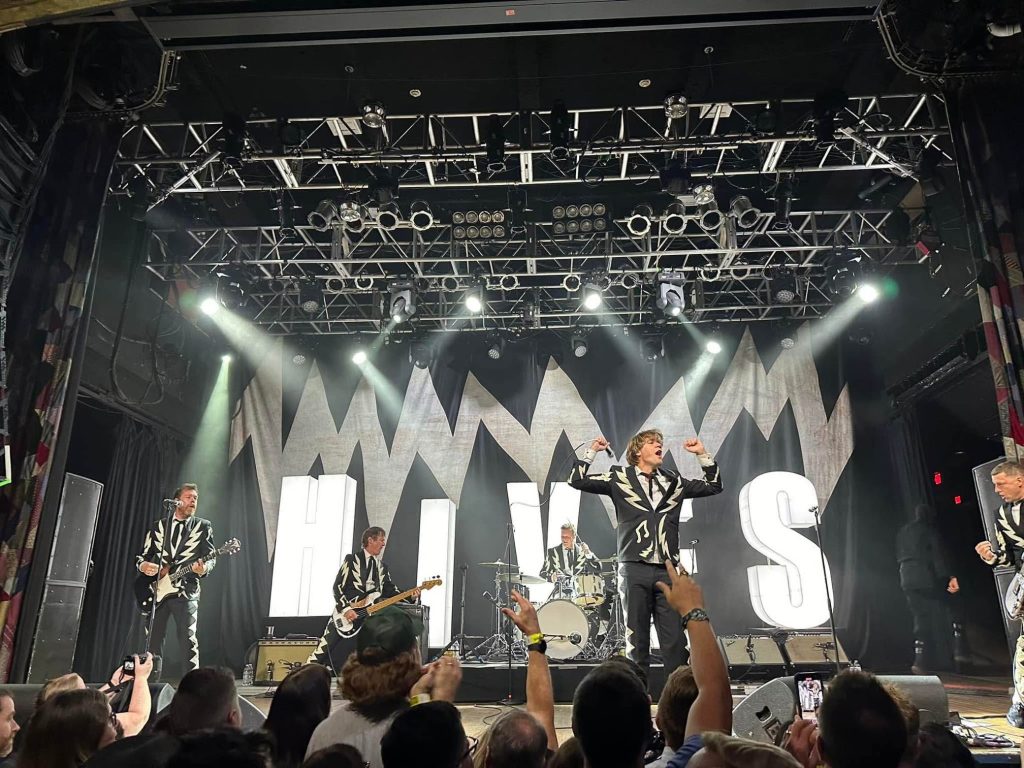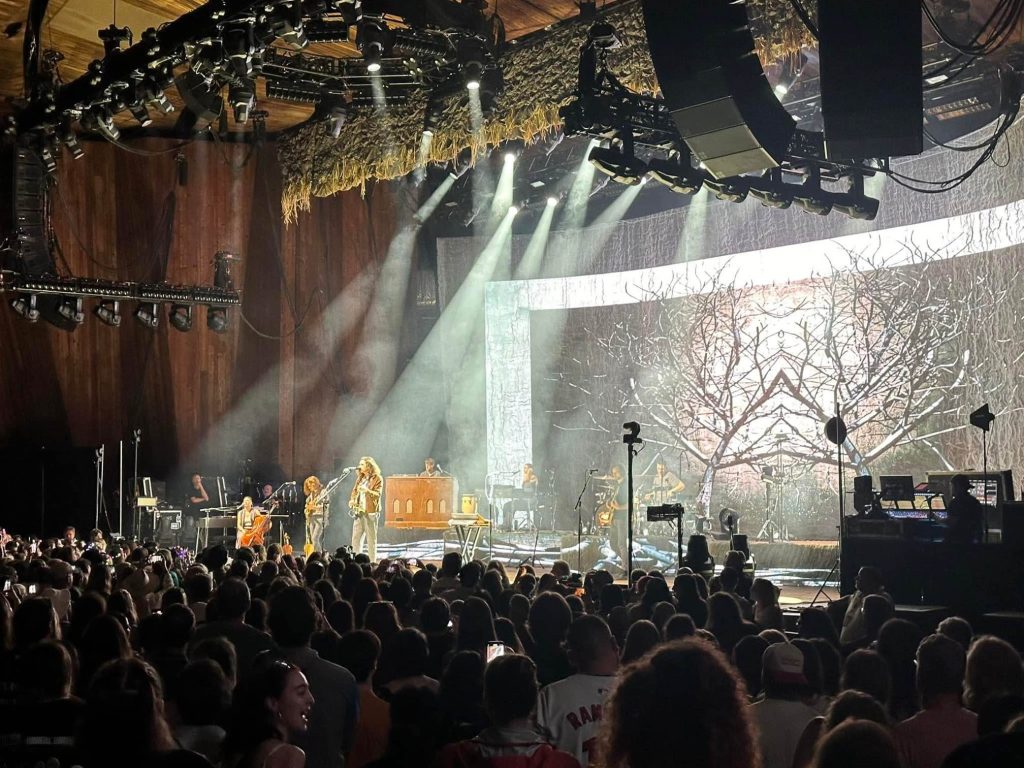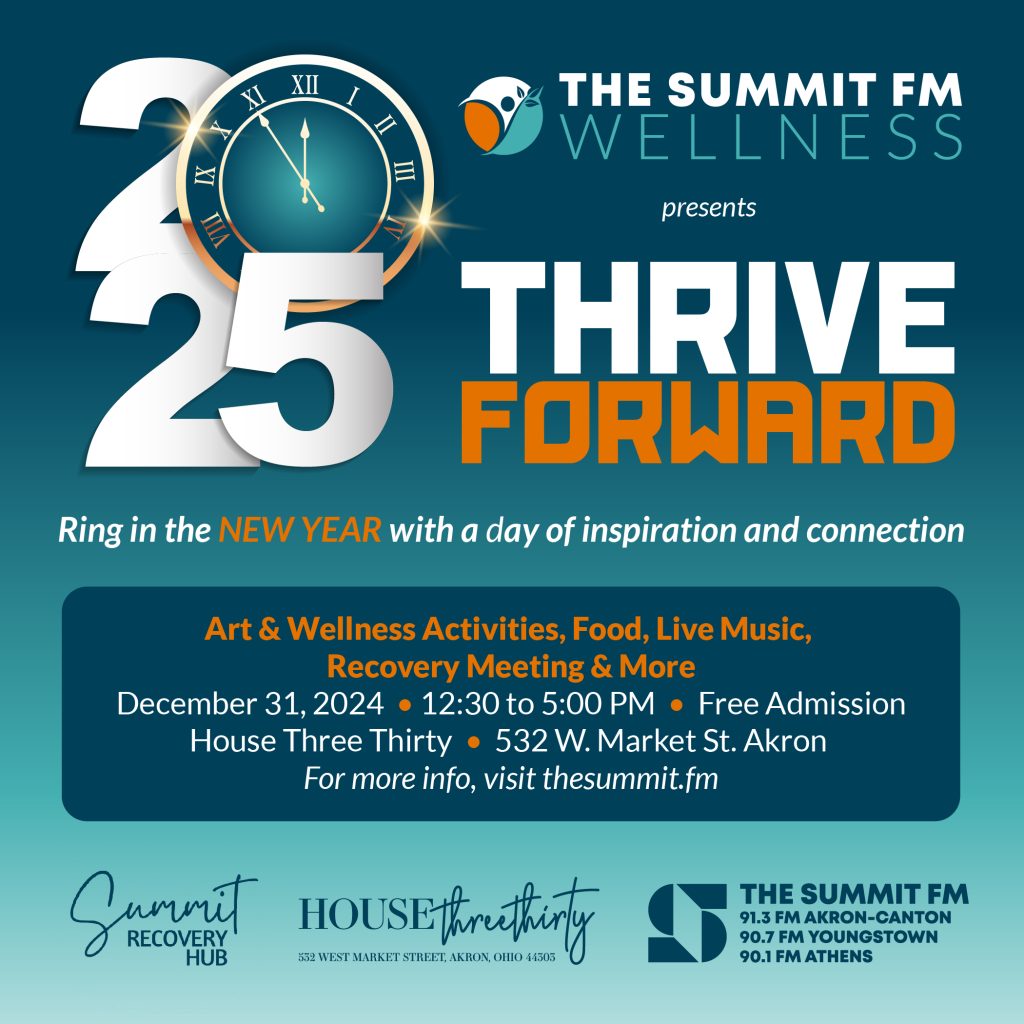By Chad Miller - Summit FM Music Director
Anyone who knows me well knows that I absolutely love going to concerts. It's my favorite thing to do. If we're being honest, it's also about the overall experience. Everything from getting excited about seeing an artist or band you're a big fan of or even casually curious about. Being inside the venue as the anticipation builds, with all the sights, sounds, senses, and history. Hanging out with a friend or several friends all evening while being surrounded by hundreds of other people, all there for the same reason: purely soaking in the atmosphere as lifetime memories of a singular moment in time are formed. Really, even just being entertained for the evening!
So, with that, I'm sharing with you my list of the 25 best concerts I've seen this year to close out 2024. Trust me when I tell you that it was HARD narrowing this down, but these live music highlights were certainly the best I was lucky enough to see throughout the year:
#25 Maggie Rose - May 30 - Beachland Ballroom in Cleveland, OH
Holy smokes! Her voice is phenomenal, and she makes it seem so effortless! On the cusp of summer, everyone in attendance was treated to a stellar performance from rootsy alt-country singer-songwriter Maggie Rose with her lively and soulful songs in the first of two times I got to see her this year. After experiencing her live show, it's easy to see why she's been nominated for a Grammy award. Deservedly so from a refreshingly down-to-earth musician.

#24 Real Estate - April 12 - The Roxy at Mahall's in Lakewood, OH
Jangly sounding and melodic indie rock at its finest with the easygoing and enjoyable sounds of the band Real Estate with a very satisfying sold-out concert that night just outside of Cleveland. They’ve been favorites of mine for a long time and getting to hear their song "Water Underground" live that night, one of my favorites of 2024, was a true highlight. Music that's so pleasant and easy to love in a way that'll have you humming along in no time.

#23 Alvvays - April 18 - Agora Theater in Cleveland, OH
Taking a well-deserved victory lap as part of an additional brief round of touring in support of their outstanding third album, "Blue Rev," released in late 2022, these guys finally hit northeast Ohio in the process. They're the total package of charming, adorable, eminently likable, nerd-friendly Canadian indie rock. What's not to love?! The Toronto-based band Alvvays put on a super fun concert, kicking off their tour that spring evening in Cleveland.

#22 Iron & Wine - August 20 - Agora Theater in Cleveland, OH
Coming off a spellbinding Studio C session earlier in the day at The Summit, it was quite a mesmerizing concert from Iron & Wine elevated by the backdrop of shadow puppet art created by Chicago-based collective Manual Cinema. Doing so in real time added a uniquely captivating background aesthetic that was hard to take one's eyes off of. All in good time, though, it was a fantastic visual element combined with the music of Sam Beam and his band.

#21 Bully - April 27 - Federal Frenzy in Youngstown, OH
It was a perfect day in Youngstown on the last Saturday in April for the annual "Federal Frenzy 2024" music festival, with headlining act Bully and many local bands performing throughout the day. The good folks at YSU Penguin Productions organize a great event each year, with Penguin City Brewing hosting and Forty Two Event Productions setting everything up. Meanwhile, as expected, Bully showed everyone how to rock out that night as they do!

#20 Detention / Off-Leash - June 29 - Akron, OH
It's always very rewarding to see the local bands in our 330 area code take the next step in their evolution. It can be both daunting and gutsy at the same time. That was the case with a historic moment as the world premiere debut of the new iteration of Akron local band greats Detention, now known as Off-Leash, blew away the sweaty crowd that hot summer night with their all-out high-energy rock assault. A new chapter begins for this defiant young band.

#19 Hinds - October 22 - Grog Shop in Cleveland Heights, OH
Certainly, one of the more charming and effervescent acts we’ve had here at The Summit in a long time as Madrid, Spain-based band Hinds were kind enough to join our members for a Studio C session. After that, these ladies displayed youthful exuberance and joyfulness humanly possible as they put on an irresistible concert with non-stop smiles all night in Cleveland Heights. Energy for days and a must-see live band!

#18 Thee Sacred Souls - July 28 - Nelsonville Music Festival in Nelsonville, OH
When the lineup was finally announced in late March, one of the bands I looked forward to seeing the most at this gem of a music festival held that coveted headlining spot on the last night. This group's retro soul vibes were the perfect close to an epic weekend in southeast Ohio. Lead singer Josh Lane's comfort level and earnestness were engaging, but his taking off running into the crowd during a few songs endeared the band to everyone.

#17 The National - September 21 - Blossom Music Center in Cuyahoga Falls, OH
How could this be The National's first tour stop in Cleveland in seventeen years?! It's been a long time since then when they were hitting their stride. This night, however, part of a co-headlining tour with The War on Drugs, was nothing short of magnificent on a beautiful night when summer changed to fall. The band ran through new and old favorites with the assured and steady conviction that defines their live show.

#16 The Hives - September 17 - House of Blues in Cleveland, OH
Patience paid off as I saw this legendary Swedish garage rock band in concert for the first time after waiting over twenty years after discovering their breakthrough album "Veni Vidi Vicious" in 2002. The showmanship and especially the charm were off the charts from lead singer Pelle Almqvist, who led the way, whipping the crowd up into a frenzy and seeming like the ringleader of a circus with his one-liners. It was every bit of a good time as I’d anticipated!

#15 Hozier - August 6 - Blossom Music Center in Cuyahoga Falls, OH
Upon having some of the biggest songs across America over the course of this past summer, northeast Ohio turned out in droves to see the great Irish singer-songwriter Hozier, who put on a highly anticipated performance at Blossom. The threat of heavy thunderstorms thankfully held off as the packed crowd was treated to an emotional and poetic night of songs that were quite powerful to see and hear. He is one of the best at what he does.

#14 Mdou Moctar - June 20 - Beachland Ballroom in Cleveland, OH
Good lord, this band absolutely ROCKS!!! Third time seeing Mdou Moctar, the Tuareg guitar rock band from Niger, and these guys completely obliterated a sold-out crowd. It was nearly impossible to move inside the Beachland that night! Out of this world guitar riffing and rock grooves at the speed of light with a sound that's unlike pretty much anyone else out there. Highly recommended and well worth your attention. Whew… that was a killer show!

#13 Stephen Sanchez - August 7 - Jacobs Pavilion in Cleveland, OH
This young man is a STAR! At just 22 years old, he's very much an old soul. At the same time, what an absolute dreamboat this young fella is! Incorporating the stage production of an old time-y television variety show in between songs while onstage, Sanchez and his magnetic retro crooner troubadour vibes had all the young girls in attendance screaming their approval throughout his dazzling performance that warm summer night in Cleveland.

#12 Lake Street Dive - July 9 - Temple Live Masonic in Cleveland, OH
It is literally impossible not to love this band or resist getting caught up in their charismatic stage presence, especially from unstoppable lead singer Rachael Price. Lake Street Dive is equal parts sassy, seductive, sultry, and oozing with charisma for days. They absolutely had this crowd going bananas on a wild evening, and the audience seemed even more swept away than usual, dancing around like I've never seen before at one of their gigs.

#11 Green Day - September 1 - PNC Park in Pittsburgh, PA
Well, it's not every day you get to go to an actual stadium concert! This one had all the '90s alt-rock nostalgia feels, too, with Smashing Pumpkins and Rancid also on the bill. It all has to be as BIG as humanly possible at these massive venues, and that's exactly what Rock and Roll Hall of Famers Green Day did as they ran through both classic albums "Dookie" AND "American Idiot," marking their respective anniversaries along with other mega-hits along the way.

#10 Vampire Weekend - September 19 - Blossom Music Center in Cuyahoga Falls, OH
It's easy to forget sometimes just how many bangers were stacked into this band's first two albums, and it was so good to hear those old classics and music from the new album. These NYC indie-rock forefathers played all the hits and then some, including an encore of random, off-the-cuff cover songs by fan request! Vampire Weekend charmed everyone in attendance on a beautiful early fall night in one of the more engaging concerts I saw all year.

#9 Waxahatchee - August 26 - Carnegie Music Hall in Pittsburgh, PA
As a longtime superfan of her music, I'm not ashamed to say that I was totally swooning all night after this absolutely wonderful performance from Katie Crutchfield's musical project Waxahatchee in a breathtakingly gorgeous venue in Pittsburgh, which I’d not been to in fourteen years. This was one of the shows I looked forward to most all year, and it did not disappoint. It was a terrific show of confidence from one of the great songwriters and voices of our generation.

#8 Alanis Morissette - July 17 - Blossom Music Center in Cuyahoga Falls, OH
An evening filled with ‘90s nostalgia, with the one and only Alanis in concert exuding pure joy onstage with all those megahits we know and love. To be able to hear an insanely packed crowd sing along WAY out loud to those familiar favorites brought up some emotions and nostalgic memories in that time of life during my youth that I don't think I was fully prepared for. One of the most enjoyable concerts I’ve been to in a long time and my first time finally seeing her!

#7 King Gizzard and the Lizard Wizard - August 24 - Jacobs Pavilion in Cleveland, OH
This one was absolutely WILD! After being familiar with their hyper prolific album output, I literally went to see what all the fuss was about, and WOW… this Australian psych-rock band slayed that late summer night alternating between jam band territory, to scuzzy fuzzy psych rock, to super heavy stoner metal all with effortless ease. The cult following I’ve always heard about was quite evident, with a mile-long merch line, an insanely energetic sold-out crowd, and a fierce mosh pit. This was quite unlike any concert I’ve ever seen!

#6 Khruangbin - June 5 - Kemba Live in Columbus, OH
AMAZING!!! The concert I’d been looking forward to the most this year did NOT disappoint. It never does with the unstoppable charisma and precision of execution from Khruangbin, who crushed it that night in Columbus. These three make pure magic together, individually and collectively, and they also seemed to summon the weather that night literally. Each show on the tour saw them play the new album in full, and as they played that final song, which included the sounds of rain showers, real drizzly raindrops started to fall on the crowd in attendance! They're an utterly amazing and phenomenal live band!

#5 The Kills - February 13 - Newport Music Hall in Columbus, OH
Little late to the party in getting into this band fully, but when I did about eight years ago, I was hooked and couldn't wait to see them live. That finally happened as Allison Mosshart and Jamie Hince took themselves out on tour to support their killer new album "God Games." Just the two of them on guitar, too. That’s it! Few rock bands shred with absolute fury like these two! No one comes close to being as badass as The Kills onstage, who annihilated the crowd assembled that winter evening in Columbus. It was an unbelievable rock show and I was absolutely blown away. Holy schnikes!!

#4 Jack White - August 29 - Mr. Smalls Theater in Pittsburgh, PA
The single greatest rockstar of our generation dropped a mysterious album in July titled "No Name." As the weeks went on, more layers about it came to light before its official vinyl release on August 2. After that, a tour happened--but not how musicians normally do it. Spontaneous "pop-up" concerts in small venues were announced, with sometimes only 48 hours’ notice, putting all the would-be attendees in a frenzy. Redefining the music industry while marketing his own music is what he's always done best. With his live show, it absolutely delivers, and as the buzz built for this show, which was one of the first on the "pop-up" tour, the anticipation in and around the venue was at a fever pitch. It was absolutely nuts in there as Jack White put on a masterclass of an effing rock concert on an unforgettable night in Pittsburgh.

#3 Jack White - August 31 - Newport Music Hall in Columbus, OH
Two days after the first one in Pittsburgh, I was lucky to be there again to see Jack White in Columbus! When going to a Jack White show, if you're like me and want to get one of the limited-edition concert posters and/or get as close as possible for a good spot on the crowd, you must get there early to get in line when doors open. I arrived at 4:00 pm for doors at 7:00 pm! The long wait was so worth it as this show topped the previous tour stop in Pittsburgh days before with an even more killer selection of older songs and even the further back classics! I'd also say that my love of this venue added to the memory as it was the perfect setting to see Jack White absolutely obliterate that crowd with the rock show of a damn lifetime.

#2 Pearl Jam - September 9 - Wells Fargo Center in Philadelphia, PA
I've been following this band live since their debut album in 1991. I've been seeing them live since 2000 upon graduating from college, and they've been my favorites all along for me. Going to see Pearl Jam in concert always makes you feel like you're a part of something. Life-affirming and full of heart and humanity as always from the BEST live band to ever walk planet Earth. The altruism at one of their shows does seem to manifest itself in ways you sometimes don't see coming and makes for an immensely special night of community. Not to mention the music! With these legends now twelve albums in, you never know what you'll get from one night to the next. Radio hits, deep cuts, fan favorites, songs from the new album, and potential b-sides, covers, and rarities. That's half the fun of going! Pearl Jam concert #23 was unbelievably special for me that night in Philadelphia, a city where they always deliver.

#1 Amyl & the Sniffers - July 26 - Nelsonville Music Festival in Nelsonville, OH
BEST CONCERT OF THE YEAR! I was so amped to see this band on the first night of the annual Nelsonville Music Festival this past summer. Keeping up with this fierce Aussie punk band for the last few years with their first two albums, I had always loved what I heard, especially from the force of nature that is lead singer Amy Taylor, who is one of the most in-your-face frontwomen in rock music. Back on May 21, they released a new single, "U Should Not be Doing That," which, upon hearing it by watching the music video for it, instantly became my favorite song of the year. Oh my god, it rocked with swagger, bravado, and raucousness for days! Seriously...watch this music video!!! That first evening of NMF in which they performed, it was all I could do to leave the radio station at a decent hour to make the two-and-half-hour trip down there in time to see them, but I made it just in time! What I saw was utterly insane as the band unloaded absolute fury and energy, with Taylor moving, gyrating, and rocking out continuously on stage for the entire hour-long set. It was one of the most powerful performances I've ever seen, and I was still buzzing about it the rest of the weekend. After experiencing such an incredible and exhilarating moment of live music like that, I would run through a brick wall for Amyl & the Sniffers. The buzz afterward amongst the festival attendees was very real as well. You can see this electrifying band on May 13 at the Agora Theater in Cleveland. If you love live music like I do, I suggest you attend!

What were the best and most memorable concerts YOU attended in 2024? Email me at chad@thesummit.fm, and let me know who you were able to see LIVE!
By Sarah Swirsky - Summit FM Wellness Coordinator
The holiday season is a time of celebration, but it can also bring stress, overwhelm, and emotional exhaustion. Between endless to-do lists, financial pressures, and complex family dynamics, it’s easy to feel like the joy of the season is slipping away.
One often-overlooked tool for managing holiday stress is music. The power of music goes beyond entertainment—it can be a grounding force that soothes the mind and uplifts the spirit.
Here’s how you can use music to navigate holiday stress:
- Create a Calm Playlist
Set aside time to create a playlist of songs that help you relax. Slow tempos, soft melodies, or instrumental tracks can calm your mind and help you feel more centered. When holiday chaos strikes, press play and let the music guide you back to balance.
- Turn Stress into Movement
Dance it out! Whether it’s to a holiday classic or your favorite pop anthem, moving your body to music is a great way to release pent-up stress. It’s a mood booster that requires no special equipment—just a willingness to let go and enjoy the moment.
- Sing Your Heart Out
Singing isn’t just fun—it’s a natural stress reliever that activates the vagus nerve, a key player in calming your nervous system. The vagus nerve helps regulate your body’s stress response, and singing stimulates it through controlled breathing and vocal vibration. This can lower your heart rate, reduce anxiety, and create a sense of calm. Whether you're caroling with friends, humming a holiday tune, or belting out songs in the shower, singing can help you feel more relaxed and grounded. Plus, it’s an easy way to tap into joy and connect with others during the holidays.
Music is more than just sound—it's a way to express emotions, release tension, and build connection. Whether you’re unwinding with a serene melody or coming together with loved ones for a sing-along, let music be your companion during the holidays.
This season, take a break from the hustle and bustle, tune into The Summit FM, or find other ways to listen, including our new mindful music streaming channel, Wavelengths, available on our free app.
Summit Wellness wishes you a harmonious holiday season filled with health, connection, and music.
By Dave Swanson - Summit FM Contributor
The Blind Boys of Alabama are an American institution, keepers of the flame of a musical tradition and cornerstone. Founded in 1939 in Talladega, Alabama, the ensemble has, obviously, changed members several times over the decades, all the while maintaining the legacy established way back when. Over those years, they were always there, if mainly in the shadows of the larger music world. At some point in the early 1980s, it was like a light switch went on, and suddenly, the praises of these legends were being sung. Established rock and rollers and blues acts like Lou Reed, Prince, Peter Gabriel, Bonnie Raitt, and Bon Iver collaborated with the group, and mainstream success was calling.
In 2003, their Christmas collaborative effort, Go Tell it on the Mountain, was released to much fanfare and success. Among those making appearances on the album were soul legends Solomon Burke, Mavis Staples, and Aaron Neville, who, alongside rockers Chrissie Hynde, Tom Waits, and Richard Thompson, brought the spotlight to the project. Toss in the jazz artistry of Les McCann and the contemporary styles of Me'Shell Ndegeocello and Shelby Lynne, and it is no wonder why the album became a touchstone of modern gospel, blues, and soul. It won a Grammy that year for best contemporary gospel recording while charting at number one on the gospel charts.
The core band on the recordings was equally a powerhouse: Duke Robillard on guitar, John Medeski on organ, Danny Thompson on bass, and Michael Jerome on drums, all A-list players. Their take on Christmas classics like “Oh Come All Ye Faithful,” “White Christmas,” “Little Drummer Boy,” and “Joy to the World” presented those standards in a new light, while the collaboration with Tom Waits on the title track was nothing short of brilliant.
Since their acceptance in the mainstream, they have had their music used in countless films and television shows, performed for two US presidents, won more Grammy awards, and kept a connection to rock and soul artists via more collaborations. They even recorded their own versions of rock and roll/soul classics from the Rolling Stones, Funkadelic, Curtis Mayfield, and Stevie Wonder, to name a few.
The album in discussion here, Go Tell it on the Mountain, is a joyful soundtrack to any given Christmas. It rings out with joy, hope, and love and seems to gain ground with each passing year.
Join us for a meaningful, sober-friendly New Year's Eve afternoon celebration at House 330 at 532 W. Market St. in Akron. The day will kick off with music from The Summit FM and delicious offerings from House 330 vendors, including Secret Pizza and Taco Tuesday specials.
At 2:30 p.m., Marc Lee Shannon will host a recovery-focused meeting to help you kickstart your intentions for 2025. Then, enjoy an uplifting Music and Message performance by local musician and advocate Chrissy Strong, who brings her unique perspective as an artist in recovery.
Throughout the event, Art+ Wellness activities, hosted by Amber Keaton Art, will provide opportunities for creativity and mindfulness. This is the perfect chance to reflect, recharge, and celebrate the new year with intention.
Schedule (subject to change):
1:00-2:00 p.m. Enjoy music by The Summit FM and delicious food from House 330 vendors, including Secret Pizza and Taco Tuesday specials.
2:30-3:00 p.m. Recovery-Focused Meeting: Kickstarting Intentions for 2025, hosted by Marc Lee Shannon.
3:00 p.m. Music and Message performance by local musician in recovery, Chrissy Strong.
4:00 to 4:45 p.m. Berhane Okantah, local multi-instrumentalist, will lead a casual drum circle to enhance wellness and kick off the New Year right! All ages welcome and no experience necessary.
Art+ Wellness activities will be ongoing throughout the event, hosted by Amber Keaton Art

"Crank It Up" is a new feature on Summit Now spotlighting five favorite songs as chosen by a different Summit listener or member. Get ready to crank it up!
Guest Contributor: Noelle B.
- "Surfin' Bird" by the Trashmen This song brings back memories of not only hearing it on the radio when I was a kid, but I think the Ghoul or Big Chuck used to play this on their late-night shows.
- "Don't Eat the Yellow Snow" by Frank Zappa My older sisters used to have Zappa albums, and I always thought this song was so funny. (Don't go where the huskies go...)
- "Coming to Take Me Away" by Napolean XIV An epic song! I loved it as a kid; as a nurse, we sang this during "appropriate" moments. I recorded this on my cell phone the last time The Summit FM played it so that I can use it as a ringtone.
- "Happy Boy" by the Beat Farmers I love the singer's baritone voice, and it really is a happy song. A coworker saw the Beat Farmers play on a cruise ship last year in Cabo and said they were really good! I think the kazoo and the gargling really do it for me on that song! (Hubba, hubba...)
- "Peaches" by the Presidents of the United States When this song was released in 1996, we were moving to Texas, and on that God-awful long drive, I heard this song play like a million times. So, we were moving to the country and actually did eat a lot of peaches, but this song will always bring back memories of the trip. I just bought the CD at The Exchange recently, and I love that the young folks working there never give me the side eye when I ask them to retrieve older music from the locked case. Some of them will ask me to give them some history of music they've never heard before!
By Dave Swanson - Summit FM Contributor
Like many subgenres, country rock has somewhat murky origins. Who was first to the table, who did it best, who was most successful, and so on. While not being first, no one has been more deeply connected to the concept of 'country rock' than Gram Parsons.
Born in Florida in 1946 and raised in Waycross, Georgia, Parsons was destined for a life in music. His musical roots date back to the influence of the early 60s folk boom, a path that would eventually lead him back to his first love, country music.
In 1966, he formed the International Submarine Band, which was signed to LHI Records, a label run by singer/songwriter/producer Lee Hazlewood, at the time, a hot property due to his recordings with Nancy Sinatra. The band issued one album, Safe At Home, and was briefly signed to Columbia Records, who released one killer single, “Sum Up Broke,” b/w “One Day Week,” before falling off the face of the earth!
In short order, Parsons turned back up in Hollywood, joining the Byrds to replace the departed David Crosby. It was at this time that Parson's influence took shape. The Byrds were at a crossroads, with band leader Roger McGuinn undecided about what direction to follow following the 'Notorious Byrd Brothers' LP. He thought a straight country trip might be the answer but was just as convinced that incorporating newly acquired synthesizers and other electronic sounds was his destiny. Parsons, along with partner in crime Chris Hillman, pushed the band onto the country path and never looked back.
The landmark, if somewhat over-rated, Sweetheart Of The Rodeo, was released in the summer of 1968 to a less than overwhelming response. Part of the problem was that most of Parsons' performances were kept off the album due to contractual issues. The album, though fine, lacked a certain exclamation point that Parsons' soulful vocals added. Those original vocals have been released over the years, proving how much more solid the LP would have been with Parsons’s recorded involvement. The band was falling apart, and both Parsons and Hillman saw what could be. They left the Byrds to form the highly influential Flying Burrito Brothers.
FBB released two albums of first-rate country rock. They had killer songs, performances, style, and vibe, yet the band and albums went nowhere! Good reviews never turned into sales. They did perform at the infamous Altamont concert, which led to a deep friendship between Parsons and Keith Richards. As the story goes, Parsons long claimed that Richards asked him to come up with a steel guitar part for the song “Wild Horses,” which led Gram to claim the song was written for him, at which point he recorded a version with the Burritos, which was released before the Stones own version. Though the Burritos would continue, Parsons left the band to follow his muse towards a solo career. After hanging out endlessly with Richards, he eventually returned home to the USA and began putting together what would become G.P., his first solo album.
Recorded in late 1972 and released in January 1973, G.P. was a perfectly captured snapshot of where Parsons was at, both musical and personal, at that moment in his life. He had signed to Reprise Records, which released the album featuring members of his touring band, the Fallen Angels. At this time, he had discovered the one person who would be his perfect counterpoint, Emmylou Harris. Her beautiful vocals and presence proved the perfect flipside to Parsons, and their voices blended like the prime recipe.
The album is filled from start to finish with classics such as “Still Feeling Blue,” “A Song For You,” “Streets Of Baltimore,” “She,” and “The New Soft Shoe,” all of which became considered Gram classics over the years.
The album received extensive press coverage, and the band's live shows were a joy. However, for whatever reason, they could not rise above the swamp of cult status. At the same time, the Eagles were quickly becoming huge, selling tons of records influenced by all that Parsons had put on the table first.
Here is where that argument about who was first gets dragged in. Yes, Parsons was among the first to do the country rock thing and arguably the one who did it best; however, the Byrds were their pre-Parsons as heard on early albums. Michael Nesmith tried to work country into the Monkee’s vocabulary as early as their first album. The Beatles had covered Buck Owens. Elvis and the Everly Brothers spoke the language, as did Jerry Lee Lewis and Buddy Holly. The answer is, of course, that country music was always part of the DNA of Rock and Roll!
That said, G.P. has become a benchmark of sorts in the genre, and its follow-up, the posthumously released, 'Grievous Angel,' served as part two of a one-two punch. The legend and legacy of Gram Parsons can, in large part, be traced back to Elvis Costello, who covered two Parsons songs on his 1981 album Almost Blue, and even more significantly to Sid Griffin of the Los Angeles band the Long Ryders, who sang the praises of Parsons and his music to anyone who would listen. He was the first to write a biography on Gram, routinely perform his material, and be involved in anything Parsons-related for years to come. Between those two fans, and in later years bands like Uncle Tupelo, Gram was elevated to cult status and is now routinely mentioned as a pioneer of not only 'country rock' but the entire American genre, and they're not wrong.
G.P. is not only essential but also a significant piece of the puzzle of where rock and roll headed once the explosion of the 1960s music world was rebuilding and finding a new road ahead. While that may sound a bit lofty, the bottom line is that it is one great batch of songs.
By Dave Swanson - Summit FM Contributor
Formed in 1981, 10,000 Maniacs began their recording career with a self-released LP, Secrets of the I-Chingin 1983. While it failed to ignite, it did bring attention to the band, who, in turn, signed with Elektra Records. The follow-up, produced by the legendary Joe Boyd, the man behind the board for the likes of Nick Drake, the Incredible String Band, Pink Floyd, and many others, seemed a good fit for the band's folk-based roots. The album The Wishing Chair was released, and things began to bubble for the band, who were building a following in the 1980s tradition of college radio airplay.
With momentum behind them, Elektra decided to up the game. They called in producer Peter Asher, who had a lengthy track record of turning in hit records for artists a bit off the beaten path. The result was the band's third LP, In My Tribe, which would prove to be the calling card they had been hoping for.
Between the previous album and this one, founding member, guitarist John Lombardo, left the band, leaving not only a space in the band's psyche but also in the songwriting department as he and singer Natalie Merchant often were collaborators. With Lombardo gone, Merchant began working with other band members, which proved to be an inspiration. Most of the album's dozen tracks were collaborations between Merchant and others. “Like The Weather” and “What's The Matter Here?” were released as singles that, while failing to set the radio on fire, did find a home on college airwaves.
Then, there was the matter of their cover of Cat Steven's classic “Peace Train.” The song was recorded for the LP and appeared on initial pressings. Being a well-known song to begin with, it started to garner radio. It was initially the album's calling card, that is, until Stevens, aka Yusef Islam, got tangled up in a religious controversy revolving around author Salman Rushdie and his book The Satanic Verses. With Stevens, a full-fledged Muslim, the views expressed in the Rushdi book were heaped with controversy by the Muslim community. As Stevens/Islam not only sided with but supported the killing of Rushdie, the Maniacs found themselves in the middle of a controversy not of their own making. The song was removed from subsequent pressings of the album. As the story goes, the band was never too keen on recording the song, but it was suggested by producer Asher. It has largely been unavailable since.
The momentum the band had built up continued as the band hit the road, seeing audiences grow date by date. Band friend Michael Stipe of R.E.M. contributed vocals on “A Campfire Song,” and their connection to R.E.M. helped the band rise in status. The album, nearly titled Bow to Mecca and You Happy Puppets(according to a 1987 interview with Merchant), would eventually rise to No. 37 on the Billboard charts and sell over two million copies.
The band would continue to ascend, but in 1993, Merchant left to pursue a successful solo career that continues to this day. The Maniacs, meanwhile, are also still active, but the ball really began rolling with 'In My Tribe', certainly an essential part of 10,000 Maniac’s history and a long-time Summit staple.
Celebrating Native American Heritage Day: The Lasting Influence of Native Cultures on Modern Music
On Native American Heritage Day, we honor the profound contributions of Native cultures to modern music. Their rich traditions—expressed through rhythms, instruments, and storytelling—have shaped countless genres, leaving an enduring legacy.
Below, we highlight how America’s First People have influenced music history:
1. Traditional Roots in Modern Music
Native American music is deeply rooted in spiritual and cultural traditions, serving as a foundation for storytelling, celebration, and connection. Its distinctive elements—such as percussive rhythms, haunting flute melodies, and vocal chants—have not only preserved cultural heritage but also profoundly influenced modern genres, from rock to ambient music.
- Drumming and Rhythms: The drum, often called the "heartbeat" of Native culture, has influenced percussion in rock, jazz, and electronic music.
- Flute Melodies: The soulful tones of the Native American flute, popularized by artists like R. Carlos Nakai, have shaped new-age, jazz, and classical music.
2. Pioneers Across Genres
Rock and Blues
- Link Wray (Shawnee): His 1958 hit Rumble introduced the power chord, a precursor to punk and heavy metal.
- Robbie Robertson (Mohawk/Cayuga): Guitarist for The Band, he infused Native themes into his music, including Music for the Native Americans.
- Buffy Sainte-Marie (Cree): A folk and protest icon, her song Universal Soldier became an anthem for social justice and Native rights.
Hip-Hop and Rap
- Supaman (Apsáalooke): Fuses rapping, beatboxing, and traditional Native music to explore identity and resilience.
- Frank Waln (Lakota): Addresses activism, environmental issues, and historical trauma through his powerful lyrics.
Pop and Rock
- Redbone: This Native American rock band gained fame in the 1970s with their hit Come and Get Your Love, celebrating Native pride.
3. Blending Tradition with Modernity
Many Native artists seamlessly combine traditional sounds with contemporary styles:
- Joanne Shenandoah (Oneida): Wove Iroquois melodies into folk and classical music.
- A Tribe Called Red (The Halluci Nation): Created “powwow step,” blending powwow music with electronic beats.
4. Advocacy Through Music
Native musicians often use their art to raise awareness about history, culture, and current issues. Their music serves as a tool for activism, ensuring Native voices are heard and their heritage preserved.
Native musicians have long used their art as a platform for activism and cultural preservation:
- Buffy Sainte-Marie (Cree): Her song Bury My Heart at Wounded Knee addresses the historical injustices faced by Native Americans, using powerful lyrics to educate and inspire action.
- Frank Waln (Lakota): His track Oil 4 Blood highlights the environmental and cultural devastation caused by pipeline projects, turning music into a call for justice.
- Supaman (Apsáalooke): Combines traditional Native dance with hip-hop to emphasize resilience and identity, often performing at schools to inspire younger generations.
5. A Vibrant Legacy
Native American artistry continues to shape global music, bridging ancestral traditions and contemporary innovation. From iconic rock legends to groundbreaking genre-blenders, their music reflects the enduring power of cultural expression.
To explore contemporary Native American music, visit the Native American Music Awards.
By Summit Now Contributor Marc Lee Shannon
In the spring of 1979, I was twenty years old and away from home, really away, for the first time. Six months prior, I was surprisingly accepted to an up-and-coming music/technology school named G.I.T., which allowed 120 students per semester. Looking back, I am confident I was #119 on the musical training and education ranking scale. Today, 45 years later, I realize how lucky I was to take the school entrance test and subsequent phone audition interview, as apparently, the examiners heard something I was unsure of at the time:
Talent.
The first part of the school's curriculum focused on sightreading music, harmony, and composition. I struggled with these areas of study, so in my apartment at the corner of Hawthorn and N. Orange, across from Hollywood High School, I made my bedroom closet into a practice den and spent every possible moment away from classes, trying desperately to catch up to the rest of the students, all of whom seemed better suited for this school than me.
I barely came up for air for the first 6 months.
In the second half of the year-long program, I had a breakthrough. In one of my first performance classes, I was assigned 2nd guitar, bass, drums, and keys and was tasked to arrange and perform a Jazz standard. I had always leaned towards more blues-based music, so I picked "All Blues," a Miles Davis tune that first appeared on his landmark Kind Of Blue record from 1959. I worked up an arrangement I thought was decent, laid the charts before my bandmates, and called the downbeat. I took the first and last solo, giving everyone their due, and after the tune finished, the class softly and politely clapped. I had a sinking feeling that I had blown it and, once and for all, should accept I was not good enough; I would not cut it at this level of talent and competition. The teacher, whose last name escapes me but was appropriately nick-named "Kimbo," began his critique by mentioning the flaws in my arrangement composition and then suggested some improvements. He was stern but fair and kind, where he did not have to be. I remember it all after all these years, especially the last thing he said. Something I will never forget.
"And kid, you were right out there (pointing to the edge of the stage in front of my classmates, some of the best budding guitarists in the world), and you were bringing it!"
His smile and that one moment of encouragement, that single compliment, were enough music-soul food that this musician needed. I knew from that moment that I could do this. I could make it with the right amount of never-give-up effort, and I would survive in L.A. and someday make a name for myself. A spark in the single encouraging sentence ignited a new trajectory for me. It infused the hope I needed to keep going and striving for my dreams.
I often think of this moment when faced with a younger, bright-eyed newbie to the game. I remember what it meant for a kid from Akron to be recognized and given the nod of approval. You never know when what you say will make that kind of difference for someone with an ambition. It might be their turning point built on the back of your uplifting, kind words. This is the power we all hold to inspire others.
That day in the performance class was a turning point, all due to a few kind words. It was the light of the fuse of my music career, all because of a compliment at the right time. All these years later, it is still something I remember, cherish, and try to pay forward. Because of that day, I will never underestimate: The Power of Encouragement.
By Sarah Swirsky, Summit FM Wellness Coordinator
Have you ever felt inspired, motivated, or relaxed by combining music and movement? If so, you’re onto something—research shows that pairing music and movement can profoundly impact mental and physical well-being. The rhythm of music naturally encourages the body to move, helping to reduce stress, boost mood, promote relaxation, and enhance coordination, balance, and overall wellness.
Here at The Summit FM, we’re all about wellness! Our Wellness Team has developed Music and Movement by Summit Wellness, a unique program that blends live music, mindfulness, and movement to foster relaxation, self-awareness, and stronger community connections.
This past October, we launched a pilot session of this program at Community Support Services, a Summit County agency devoted to bringing care and hope to individuals living with severe and persistent mental illness. We’re excited to continue bringing Music and Movement to underserved populations throughout Summit County, helping to share the transformative power of music and movement.
Music and Movement will also be available as a monthly benefit exclusively for our Summit FM members, hosted in Studio C. Keep an eye out for your invite, members—space is limited! The first session will be chair-based; no experience or skills are necessary.
Gentle movement is guided by Summit Wellness Coordinator and Licensed Social Worker Sarah Swirsky, who has completed a 300-hour evidence-based trauma-sensitive yoga training. Renowned guitarist and Certified Peer Support Specialist Marc Lee Shannon performs live music. Marc and Sarah create a calming, supportive space where participants can release tension, reconnect with themselves, and experience the transformative power of music, movement, and mindfulness.
For more information on our Summit Wellness programming, click here.








